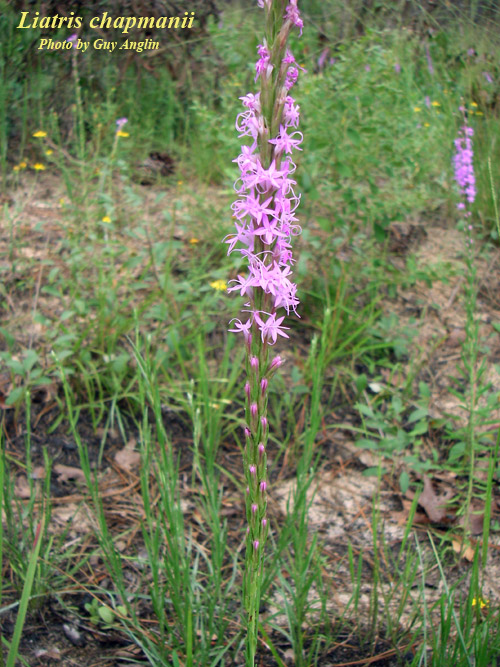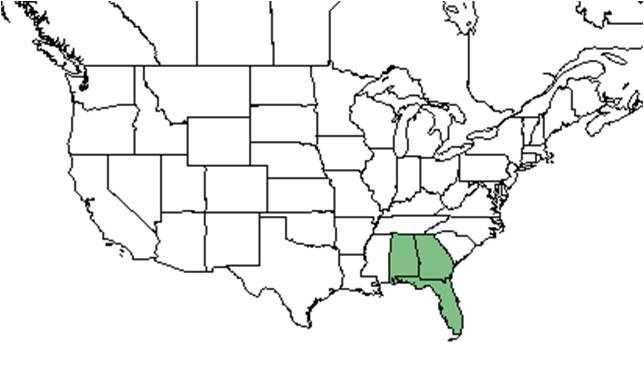Difference between revisions of "Liatris chapmanii"
Krobertson (talk | contribs) |
|||
| Line 18: | Line 18: | ||
}} | }} | ||
| − | Common | + | Common names: Chapman's blazing star, Chapman's gayfeather |
==Taxonomic notes== | ==Taxonomic notes== | ||
Synonym: ''Laciniaria chapmanii'' (Torrey & A. Gray) Kuntze | Synonym: ''Laciniaria chapmanii'' (Torrey & A. Gray) Kuntze | ||
Revision as of 15:56, 18 August 2016
| Liatris chapmanii | |
|---|---|

| |
| Photo by Guy Anglin, Atlas of Florida Vascular Plants | |
| Scientific classification | |
| Kingdom: | Plantae |
| Division: | Magnoliophyta - Flowering plants |
| Class: | Magnoliopsida – Dicotyledons |
| Order: | Asterales |
| Family: | Asteraceae ⁄ Compositae |
| Genus: | Liatris |
| Species: | L. chapmanii |
| Binomial name | |
| Liatris chapmanii Torr. & A. Gray | |

| |
| Natural range of Liatris chapmanii from USDA NRCS Plants Database. | |
Common names: Chapman's blazing star, Chapman's gayfeather
Contents
Taxonomic notes
Synonym: Laciniaria chapmanii (Torrey & A. Gray) Kuntze
Named for A.W. Chapman, one of the southeast's best known early botanists.[1]
Description
A description of Liatris chapmanii is provided in The Flora of North America.
L. chapmanii is a perennial species that grows from rounded to elongated corms.[2][3] The leaves are slightly curved, thin, and can be found along the flower stalk. The basal rosette is dense and has a whorled appearance. The puprle flowers are densely clustered along the flower stalk, with the stalk capable of reaching 3 feet tall.[1]
Distribution
Ecology
Habitat
In the Coastal Plain in Florida and Georgia, L. chapmanii can occur in longleaf pine sandhills and pine-oak-palmetto scrubs. It has been found in disturbed areas such as bulldozed pinelands and sandy fields. Soil types include loamy sand and red clay. Associated species include Quercus laevis, Ceratiola, Chrysopsis, Liatris gracilis, L. tenuifolia, Carphephorus odoratissimus, Balduina, Sporobolus, Lyonia, Myrica, Serenoa, Agalinis, and Dicerandra. [4]
Phenology
Flowers August through October.[4] The seeds are produced in cypselae fruits that have feathery bristle-like pappi.[2]
Seed bank and germination
L. chapmanii occurs in pyrogenic scrub and sandhill communities and germination is stimulated by smoke. [5]
Pollination
The following Hymenoptera families and species were observed visiting flowers of Liatris chapmanii at Archbold Biological Station: [6]
Megachilidae: Megachile albitarsis
Conservation and management
Cultivation and restoration
Photo Gallery
References and notes
- ↑ 1.0 1.1 [[1]]Native Florida Wildflowers Accessed: January 11, 2016
- ↑ 2.0 2.1 [[2]] Encyclopedia of Life. Accessed: January 11, 2016
- ↑ [[3]]Accessed: January 11, 2016
- ↑ 4.0 4.1 Florida State University Robert K. Godfrey Herbarium database. URL: http://herbarium.bio.fsu.edu. Last accessed: October 2015. Collectors: Loran C. Anderson, B. Boothe, M. Boothe, Edwin L. Bridges, A.F. Clewell, George R. Cooley, Robert Doren, R.J. Eaton, Grayal Farr, Robert K. Godfrey, Norlan, R.A. Norris, C. Henderson, R. Kral, Olga Lakela, John Lazor, Robert L. Lazor, K. MacClendon, Travis MacClendon, Sidney McDaniel, J.B. McFarlin, Thomas Miller, Steve L. Orzell, Paul L. Redfearn Jr., Cecil R. Slaughter. States and Counties: Florida: Bay, Calhoun, Collier, Escambia, Franklin, Gadsden, Gulf, Highlands, Hillsborough, Indian River, Jackson, Leon, Liberty, Martin, Pinellas, Polk, Wakulla, Washington. Compiled by Tall Timbers Research Station and Land Conservancy.
- ↑ Lindon, H. L. and E. Menges (2008). "Scientific Note: Effects of Smoke on Seed Germination of Twenty Species of Fire-Prone Habitats in Florida." Castanea 73(2): 106-110.
- ↑ Deyrup, M.A. and N.D. 2015. Database of observations of Hymenoptera visitations to flowers of plants on Archbold Biological Station, Florida, USA.